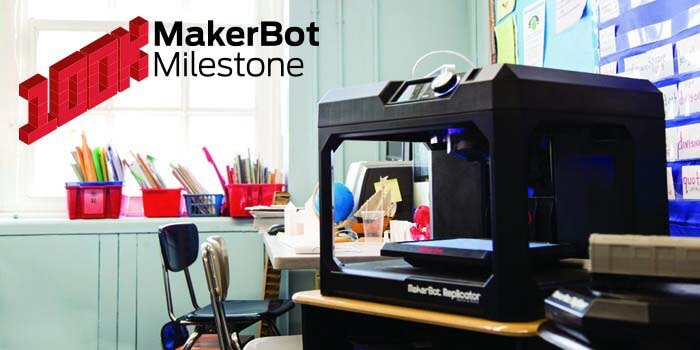Consumer 3D-Printer Maker MakerBot has Sold over 100,000 3D Printers Worldwide

Consumer 3D-printer MakerBot reported last week that it had reached an impressive milestone: it’s sold over 100,000 3D printers worldwide, and is the first company in the 3D-printing industry to reach this milestone.
MakerBot, which was founded in 2009, is one of the pioneers in the consumer and educational 3D-printer market. It was purchased by professional 3D-printer maker, and one of the leaders in the 3D-printer market, Stratasys, in 2013 for $604 million.
After being acquired by Stratasys in 2013, MakerBot introduced its fifth-generation 3D printers in 2014, which were the first desktop 3D printers with WiFi wireless connectivity and a swappable Smart Extruder. Over 40,000 of MakerBot 3D printers are currently Wi-Fi connected. MakerBot’s Thingiverse – MakerBot’s online platform that enables users to share and create 3D designs – also recently hit a major milestone when, in October 2015, MakerBot announced one million uploads to Thingiverse.
MakerBot introduced its first 3D printer, the Cupcake CNC, at SXSW, in 2009. In 2010, it became the first company to present a 3D printer at the Consumer Electronics Show (CES).
To celebrate its 100,000-shipment milestone, MakerBot is reducing the pricing for its MakerBot Replicator Desktop 3D Printer from $2,899 to $2,499 until June 15, 2016.
“Being the first company to have sold 100,000 3D printers is a major milestone for MakerBot and the entire industry,” commented MakerBot CEO Jonathan Jaglom. “MakerBot has made 3D printing more accessible and today is empowering businesses and educators to redefine what’s possible. What was once a product used only by makers and hobbyists has matured significantly and become an indispensible tool that is changing the way students learn and businesses innovate.”
Over the last several years, MakerBot customers have created various ground-breaking designs, including a prosthetic human hand created together by a woodworker from Johannesburg, South Africa, and a theatrical prop designer from Seattle, Washington. Other customers include the Feinstein Institute, which is also using MakerBot 3D printers to created tracheal replicas to perfect its construction of tissues used in patients.
MakerBot 3D printers are also increasingly being used in education: “3D printing has become a major focal point in our school with children as young as five using tools like MakerBot PrintShopto to create their own designs,” says Yolanda Valencia, chair of Science and Engineering at Gulliver Middle School in Miami, Florida. “Because MakerBot 3D Printers are so easy to use, our middle-school students can move on to more advanced projects. Right now they are working together to find sustainable solutions in urban planning and above all learning crucial skills that they will use for the rest of their lives like critical thinking, collaboration, and product development.”

You must be logged in to post a comment.